Stopping a Horse Quickly
When most people are on runaway horses, they panic and pull back on two reins to try to stop the horse. At the same time, their entire body tightens up and they squeeze the horse’s sides with their legs. Curling up into this fetal position only makes the horse feel trapped and claustrophobic. As a prey animal, the horse has a flight or fight response, and when his ability to run is taken away from him, he’ll do whatever he can to survive the situation by bucking, rearing, kicking out, etc. What most people don’t realize is that they have better control of a panicked horse with just one rein.
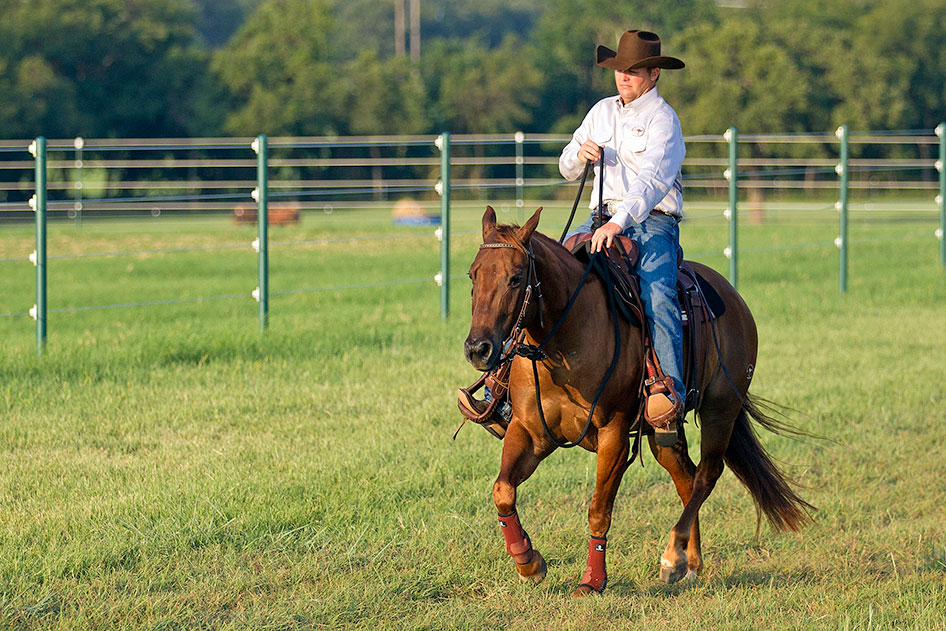
Why use one rein instead of two to control a horse? Using two reins makes a horse feel trapped, and it’s very easy for him to get leverage by lifting his head and neck up and pushing against the rein pressure you have on his face. With just one rein, you can make the horse bend his head and neck laterally, causing him to yield his hindquarters. If you teach your horse how to properly do a One Rein Stop, you’ll always have control of him and be able to prevent a dangerous situation before it happens. You should be able to flex your horse’s head to your toe, have him stop moving his feet and soften from the walk, trot and canter. Anytime a horse disengages his hindquarters, his gas pedal and balance are immediately taken away from him. It’s like pushing in the clutch of your car. Without a gas pedal, he can’t go anywhere, and without balance, he can’t rear or buck. I refer to the One Rein Stop as an emergency handbrake because anytime you feel unsafe or out of control, you can slide your hand down one rein causing the horse to yield his hindquarters and stop immediately. Horses don’t like being scared, so when you’re in control and give them leadership, you’ll be amazed at how fast they’ll start to relax in any situation.
However, in order for the One Rein Stop to work effectively, you have to prepare and teach your horse how to react when you sit back in the saddle and slide your hand down the rein. Otherwise, when he’s panicked and running from a perceived danger, he’ll get confused and panic more when you pick up on the rein.
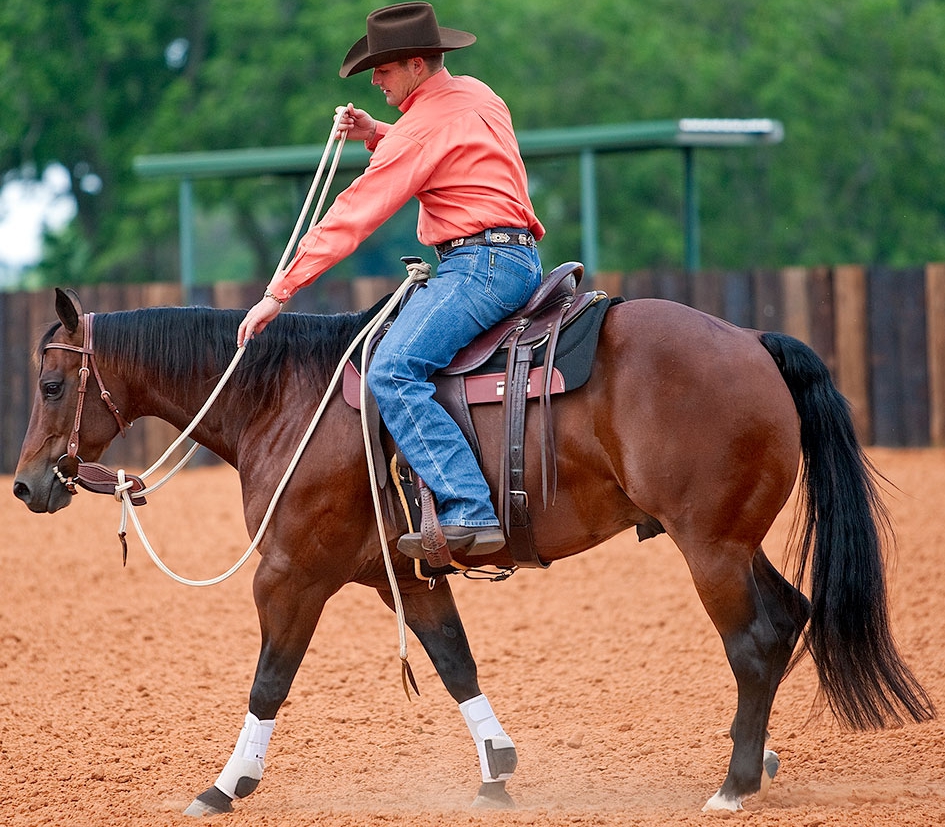
When you slide your hand down the rein, be sure to stay sitting back in the saddle. Many riders have a tendency to lean forward over the horse’s neck which puts them in a dangerous position.
Steps to a Successful One Rein Stop
1. Find a safe, controlled environment to practice.
I recommend practicing One Rein Stops in a controlled environment at first, like in a roundpen or in a safe arena. Once you and your horse are comfortable doing One Rein Stops, then you can practice them in an open pasture or out on the trail. It’s important to be in a controlled environment when teaching a horse to do One Rein Stops because you’re only working on establishing a good gas pedal and a good brake, not a steering wheel. When you practice this exercise, let the horse go wherever he wants; don’t worry about directing him. The One Rein Stop is a controlled impulsion exercise, which means that you’re teaching him to go the exact speed you want him to go.
2. Ask the horse to go forward at the walk by squeezing the middle of his ribcage with both legs.
If he doesn’t immediately respond by moving forward, cluck two times with your tongue: “cluck,” “cluck.” If he still doesn’t respond, spank him with the end of your reins from side to side or use a dressage whip to tap him.
Squeeze is asking the horse to go forward, and if he doesn’t respond, you’ll cluck. Clucking warns the horse that he is about to feel uncomfortable. Spanking is exactly that, spanking. In the beginning, when you spank the horse, you don’t want to spank really hard from side to side. Just start out gently spanking. If the horse still doesn’t respond, then you can gradually increase the pressure as you spank with rhythm until you get him to move his feet. The more sensitive the horse is, the less you’ll have to spank. The duller and lazier he is, the harder you’ll have to spank. Do what you have to do to get the job done. Do it as easy as possible, but as firm as necessary.
When you squeeze the horse with your legs, just squeeze once. Don’t squeeze, release, squeeze, release. If he doesn’t respond, that’s his decision. Resist the temptation to kick him because kicking shortens a horse’s stride and makes him tighten up. Instead, spank with rhythm because spanking lengthens a horse’s stride and encourages him to move forward.
Always start the exercise at the walk because the faster you go, the more of a tendency the horse will have to pull against you and resist the pressure on the reins. Always start slow and build to a faster speed once the previous one can be done with confidence. Make sure you continue to squeeze with your legs the whole time you’re clucking and spanking. Only release your legs when the horse goes the speed you want. The horse’s reward for going the correct speed is the release of your legs.
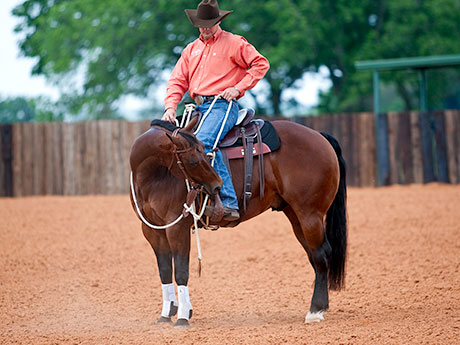
Continue to hold the rein until the horse comes to a complete stop.
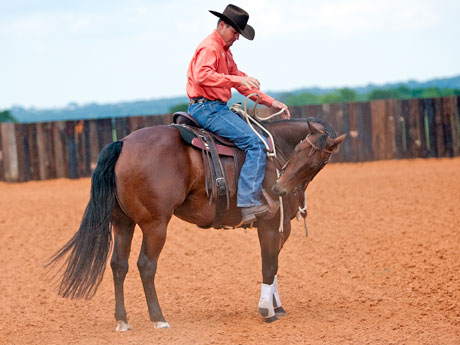
As soon as the horse softens and gives to the pressure, instantly release the rein.
3. Once the horse is moving forward at the walk, let him walk 40 to 50 feet before asking for a One Rein Stop.
Don’t steer him. Let him go wherever he wants to go, holding one hand on the middle of the reins down in his mane. To ask for a One Rein Stop, sit back deep in the saddle, take your legs off, then slide your hand halfway down the rein and pull the rein up to your hip bone.
4. Hold the pressure at your hip until the horse stops moving his feet and softens his face. Make sure that your horse’s nose touches your boot, jeans, stirrup or fender before you release the rein.
5. The instant the horse stops moving his feet and softens, immediately drop the rein out of your hand.
Don’t release the rein pressure until he stands still and softens. Just because the horse stops, it doesn’t mean you should release the pressure. He has to soften too. Once you release, flex him once to the other side by picking up the opposite rein and pulling it up to your hip. As soon as the horse softens and gives to the pressure, instantly release the rein.
6. After flexing the horse’s head once each way, ask him to walk off again by first squeezing with your legs and then clucking if he doesn’t respond.
If he continues to ignore you, spank behind your leg with rhythm until he walks forward. Let the horse walk 40 to 50 feet before asking for another One Rein Stop.
Don’t stop the horse with the same rein all the time. If you stopped him with the right rein the first time, the second time stop him with the left rein. Remember, horses have two separate brains, the right brain and the left brain, and each side needs to be trained independently from the other.
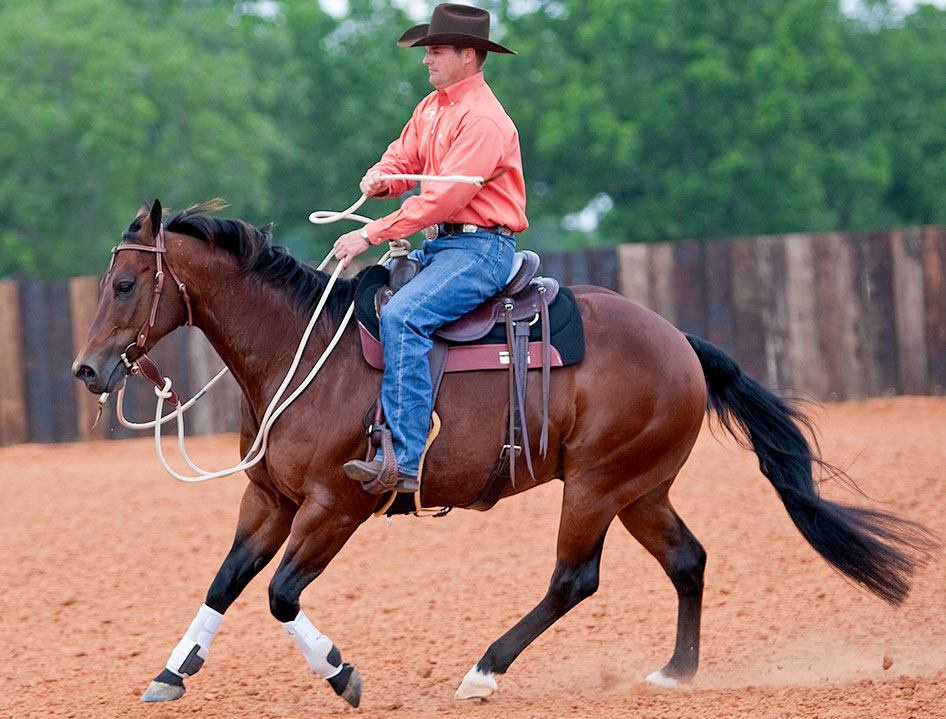
If at any time your horse breaks gait, squeeze, cluck and spank until he goes the speed you want. Don’t kick the horse to go forward because kicking will just shorten his stride.
7. When you’re comfortable asking the horse to do a One Rein Stop at the walk, and he understands what you’re asking, move on to the trot.
You should post to the trot and then sit two or three strides before asking him to stop. It’s what I call, “Sit before you pull.” If you sit before you pull you’re giving the horse a pre-signal of what is going to happen. With repetition, he’ll start reading your body language and realize when you sit down and relax, he should come down to a stop even before you pick up on the rein and flex him. By sitting deep in the saddle, there is a dramatic difference in your body position making it easier for the horse to understand what you want. When you post, your body is full of energy and signals the horse to go forward. When you sit, exhale and let all the air out of your body to encourage the horse to stop moving forward. If he doesn’t stop, you’ll of course slide your hand down one rein and ask him for a One Rein Stop. Eventually, with enough repetition, as soon as you relax your seat, the horse will stop, and you won’t have to rely on the rein to stop him.
8. After you’ve taught the horse how to do the exercise at the trot, then practice the same steps at the canter.
Once he’s in the canter, only let him go four to five strides before asking for the One Rein Stop. By only letting the horse go a short distance before shutting him down, it won’t take long for him to realize that he might as well slow down and relax because he’s not going very far before you ask him to come to a stop. This is especially important for hot-blooded horses that like to run and build speed. Don’t let the horse build his speed up to ninety miles an hour, and then worry about how you’re If at any time your horse breaks gait, squeeze, cluck and spank until he goes the speed you want. Don’t kick the horse to go forward because kicking will just shorten his stride. going to stop him. Shut him down before he gets out of control. Of course, if you have a lazy horse that doesn’t want to run, you might let him canter ten or fifteen strides before asking him to stop because you’re trying to encourage forward motion. If he breaks gait, Squeeze, Cluck, Spank again.
Notice that whenever you ask the horse to go forward or speed up, you’ll squeeze, cluck and spank. Kicking the horse does not fall into that equation. The reason for this is that kicking actually shortens a horse’s stride; it’s spanking that lengthens it. Think about this: If kicking a horse was really the most effective way to get a horse to go forward, why wouldn’t jockeys wear spurs? When a jockey wants a horse to move forward, he uses a crop to spank the horse behind his legs. Is it possible to get a horse to go faster by kicking him? The answer is yes. However, most people, especially people that own a very lazy cold-blooded horse, cannot kick hard enough to make the horse feel uncomfortable for being lazy. The horse just ends up becoming dull to the kicking sensation. Spanking will light a fire under his feet much quicker and with much less effort on your part.
Once you’re confident that the horse is not going to buck or bolt, slowly start letting him canter further and further before asking him to come to a stop with one rein. Within three to four days, your horse should be able to canter twenty or thirty strides before you bring him to a stop with one rein.
Your horse is programmed to run first and think later. But you can take steps to ensure that you have a safe and enjoyable ride despite his flight instinct. One Rein Stops are a surefire way to maintain or regain control, giving you the confidence of knowing that your horse will respond to your cues, even when the pressure is on.

A Lifesaving Exercise
When the topic of One Rein Stops comes up, there are plenty of people who roll their eyes and brush the exercise off. “That’s just for novice riders or those with no confidence,” they say. “I know how to ride a horse.” Or maybe they understand the importance of the exercise, but never take the time needed to practice it before going out on the trail or taking their horse away from home. It’s important to practice One Rein Stops in a controlled environment so that when an emergency does present itself in an uncontrolled environment such as on a trail ride or at a horse show, it’s automatic for you to pick up on one rein and bring the horse to a stop. As soon as you slide your hand down the rein, your horse’s response should be to soften and come to a complete stop. Think of the One Rein Stop as your emergency handbrake and a way to instill confidence in your horse.
Over the past eighteen years, I can name at least seven times a One Rein Stop has saved my life. I know for a fact that if I hadn’t been able to bend my horse around and do a One Rein Stop in the real life situation below, I wouldn’t be alive today.
Often during my apprenticeship with Gordon McKinlay, we’d spend the day mustering cattle. A lot of the crop farmers in the area raised cattle as a side business, and while they were very good at growing crops, they didn’t know the front end of a cow from the back end. They would run the cattle into the stockyards on motor bikes, four wheelers and choppers. After three to four times of doing a poor job at rounding the cattle up, they couldn’t even get them near the yards. In desperation, they used to call Gordon and I for help. We’d spend all day mustering the cattle and getting them into the stockyards. We could be in a small pasture or a twenty-thousand acre field and some of it was pretty wild.
The thing I loved the most about mustering the cattle was we could ride our horses for eight to twelve hours at a time, and the entire time we’d be walking, trotting, cantering and mixing it up. We could easily train on them for ten hours a day, but they never got sour because they always had a purpose. When you give animals a purpose, they love their jobs.
Very early on in my apprenticeship, we went out mustering on a big ranch in central Queensland. At the time, I was riding a green 3-year-old mare that hadn’t had a lot of riding. She was a hot little horse that was kind of spooky and flighty in general. In fact, on that particular day, it was only her second time being ridden outside. Of course she was eyeing things in the tall grass and being pretty tentative about the whole deal. Gordon had taught me that one of the best ways to get a horse to relax was to get their feet moving so that they would start using the thinking side of their brain. I knew mustering cattle out on the open range was a great thing to do with this particular mare because she’d be able to move out on a big loose rein and hopefully start to relax.
For the first hour or so of the ride, she moved out and I could feel her body relaxing. She certainly wasn’t trotting around like an old ranch horse, but her eyes weren’t rolling into the back of her head either. As we were moving through the long grass, I was feeling good about the situation and started to let my mind wander. All of a sudden, that mare came to a dead stop and jumped sideways. As I fought to keep my balance, I could see an old tree stump hidden in the grass out of the corner of my eye. When she saw it, she shied away from it as if it were a rattlesnake. She jumped sideways out from underneath me so fast with such little warning, that I halfway lost my balance and was left hanging off the side of the saddle. When she saw me hanging off the saddle, she got even more scared and took off at a dead run. And believe me, that mare could run. It felt like I clung to the saddle for an eternity as the ground rushed below me and her hooves struck the ground, but I eventually lost my grip and fell. Luckily, I was no worse for wear besides a bruised ego.
I picked myself up off the ground, caught the mare, dusted my jeans off and got back in the saddle. Of course, she was worked up, but as soon as I got in the saddle, I started flexing her head from side to side. She began to soften and relax, and I made sure that she had her attention back on me before moving off again. As we started to cover ground, she relaxed even more and I started searching for stray cows in the tall grass. No sooner did I take half my attention off of her, when she spooked and bolted again, but this time, there was nothing to spook at. When she jumped out from underneath me, I wasn’t prepared and couldn’t get her head bent around quick enough and ended up falling off again.
“The more times you pick yourself up off the ground, the quicker your one rein stops will get.”
As I climbed back into the saddle, I was humiliated that the mare had gotten the best of me a second time and resolved to be ready for her if she tried to spook again. I rode her defensively with one hand holding the reins and the other on the saddle horn – just waiting for her to spook at something.
Sure enough, an hour later, she spooked and shied again. I was half off of her before I could get her head bent around. I was almost to the point where I was going to fall off again, but something told me to keep trying. When I finally got her to stop, I looked down and saw that my entire boot, spur included, had slipped through the stirrup. That sent chills racing down my spine because I knew if I had fallen off of her, I wouldn’t have been able to get my foot out of the stirrup. That mare was so spooky and flighty that if I would have fallen off and gotten drug, she would have kicked at me and galloped off until there was nothing left of me. I called out to Gordon and he gently walked up to the mare, repositioned my foot and helped me get back into the saddle.
That close call taught me a very important lesson about not only the necessity of the One Rein Stop, but the importance of preparation. The One Rein Stop only works if you’re prepared to use it. If you haven’t practiced it or have only gone over the exercise once or twice with your horse, it does you no good. Executing a One Rein Stop has to be second nature to you. That’s why in my clinics I spend a lot of time having the participants practice just the motion of sliding one hand down the rein. If you’re out on the trail and your horse spooks and shies away, you need to be able to immediately slide your hand down one rein, bend the horse’s head around and bring him to a stop. If you haven’t practiced the One Rein Stop before, the horse won’t know what to do when you pick up on the rein and will continue to be reactive. The One Rein Stop can save your life, but both you and your horse have to be prepared to use it.


Want To Learn More? SIGN UP FOR OUR LOYALTY PROGRAM
Master your horsemanship training through Clinton’s step-by-step method videos by joining the No Worries Club today. Becoming a club member ensures you get VIP pricing on all of Clinton’s must-have training tools and resources. Plus, you’ll enjoy all the phenomenal benefits that come with club membership!


